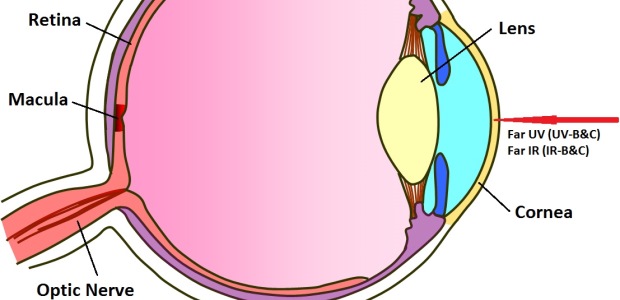
Laser Safety: The Eyes Have It!
Eye injuries are of primary concern. The effect to the eye depends on various factors, including pupil size, pigmentation, laser pulse duration and repetition, and wavelength.
- By Chuck Paulausky
- Aug 01, 2014
Pierre Gougelman had the first glass eye factory in the United States in 1851. At first, the public thought artificial eyes actually gave their wearers new sight.
If only glass eyes worked that way! Unfortunately, some lasers can result in permanent retinal damage and blindness. Lasers have many common applications these days, everything from barcode scanners and laser pointers to military laser targeting and weapons, and a wide range of medical and industrial applications. It's this last group that I’m most familiar with, having worked for several companies as the Laser Safety Officer.
Laser Light
Laser light differs from ordinary light in three ways:
- Monochromatic--Laser light consists of one color or wavelength. In contrast, ordinary white light is a combination of many colors or wavelengths.
- Directional--Lasers emit light that is highly directional, that is, laser light is emitted as a relatively narrow beam in a specific direction. Ordinary light, such as from a light bulb, is emitted in many directions away from the source.
- Coherent--The wavelengths of the laser light are in phase in space and time. Ordinary light can be a mixture of many wavelengths.
It is these differences that make the laser beams useful and potentially hazardous.
Laser Radiation
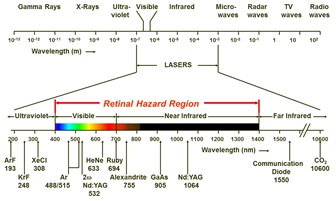 Lasers produce non-ionizing radiation, which is less hazardous than ionizing radiation, which can interfere with normal cell processes. Lasers operate within a specific range in the electromagnetic spectrum, including ultraviolet, visible, infrared wavelengths. Within this range there is the Retinal Hazard Region, which includes visible and near infrared wavelengths. Eye exposure within this region can result in permanent retinal damage.
Lasers produce non-ionizing radiation, which is less hazardous than ionizing radiation, which can interfere with normal cell processes. Lasers operate within a specific range in the electromagnetic spectrum, including ultraviolet, visible, infrared wavelengths. Within this range there is the Retinal Hazard Region, which includes visible and near infrared wavelengths. Eye exposure within this region can result in permanent retinal damage.
Laser Classes
Lasers are categorized by class, with Class 3B and Class 4 being of major concern, falling under regulatory requirements for laser safety programs. Basic classes include:
- Class 1--These are generally safe as long as they are not disassembled. The Maximum permissible exposure (MPE) is not likely to be exceeded. Common uses: CD-ROM players, drives.
- Cllass 2/2a--There is a potential hazard if you stare into the beam, but the human blink reflex usually prevents damaging exposures. Example: supermarket barcode scanners.
- Class 3a--These may pose an eye hazard if collected or focused into the eye. The MPE can be exceeded, but risk of injury is low. Example: laser pointers.
- Class 3b--These pose a serious eye hazard if direct or reflected beam is viewed, but diffuse exposures should not be hazardous. Examples: research applications, some industrial uses.
- Class 4--There is an eye hazard if direct, reflected, or diffusely-reflected beam is viewed, resulting in devastating or permanent eye damage. These also have potential for significant skin damage. They also may pose a fire risk and fume hazard, depending on the use. Examples: research, manufacturing.
Laser Bioeffects
Lasers can result in significant skin damage, so skin must be protected, but eye damage is the primary hazard. Beam damage can be in three forms:
- Thermal--This is the result of heat generated and absorbed at the site of exposure, causing burns to skin and eyes.
- Acoustic--This produces a mechanical shockwave similar to the wave effects of dropping a pebble into a pond. Acoustic effects can cause local vaporization and tissue damage.
- Photochemical--Certain wavelengths can generate chemical reactions in tissue, which in some cases can result in cataracts, corneal or retinal burns, and a greater risk of skin cancer.
Skin effects will vary from minor redness and soreness to as much as third-degree burns, depending on the laser class, pulse duration and repetition, and wavelength.
Eye injuries are of primary concern. The effect to the eye depends on various factors, including pupil size, pigmentation, laser pulse duration and repetition, and wavelength. Different wavelengths will penetrate the eyes to different levels, causing damage at that level and to the cornea, lens, or retina:
Far Ultraviolet (UV-B&C) and Far Infrared (IR-B&C)
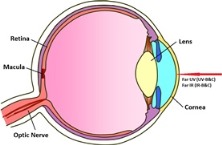 Exposures at this level can impact the cornea through absorption. Typical injuries would be corneal burns and "welder's eye," a condition evidenced by severe irritation and a feeling of sand in the eyes. Sunlight is in the Far UV range and can have the same affect. These injuries are usually temporary.
Exposures at this level can impact the cornea through absorption. Typical injuries would be corneal burns and "welder's eye," a condition evidenced by severe irritation and a feeling of sand in the eyes. Sunlight is in the Far UV range and can have the same affect. These injuries are usually temporary.
Near UV (UV-A)
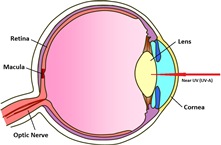 These exposures result in absorption of the radiation in the lens. The effects can be delayed and may not happen for several years. Cataracts are a typical lens injury, and may require surgery to repair.
These exposures result in absorption of the radiation in the lens. The effects can be delayed and may not happen for several years. Cataracts are a typical lens injury, and may require surgery to repair.
Visible & Near Infrared (IR-A)
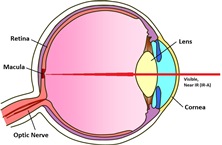 Exposures in this range can damage the retina. These exposures can be more damaging due to the focal magnification, which can increase the irradiance by ~100,000 times! Injuries can be temporary, but retinal burns can result in permanent vision loss. If the area of the retina damaged is the Macula, this can result in loss of central vision. Interestingly enough, Macular degeneration, a condition common to aging in which blood vessels swell and can cause major macular damage, is treated by lasers to cauterize the swollen vessels, resulting in smaller areas of damage and small spots of central vision loss.
Exposures in this range can damage the retina. These exposures can be more damaging due to the focal magnification, which can increase the irradiance by ~100,000 times! Injuries can be temporary, but retinal burns can result in permanent vision loss. If the area of the retina damaged is the Macula, this can result in loss of central vision. Interestingly enough, Macular degeneration, a condition common to aging in which blood vessels swell and can cause major macular damage, is treated by lasers to cauterize the swollen vessels, resulting in smaller areas of damage and small spots of central vision loss.
Laser Terms
Basic laser safety terms are used to identify, understand, and calculate the protection requirements for a specific laser operated at specific settings. Any changes to a laser setting will likely change these calculations, which are critical to employee safety:
- MPE (Maximum Permissible Exposure) is the highest laser energy to which the eye or skin can be exposed for a given laser. The MPE is similar to OSHA’s Permissible Exposure Limits for chemical exposures.
- NHZ (Nominal Hazard Zone) is the area within which the exposure to direct, reflected, or scattered radiation exceeds the MPE. No controls are required outside of the NHZ.
- NOHD (Nominal Ocular Hazard Distance) is the distance along the laser beam axis beyond which the MPE is not exceeded.
- OD (Optical Density) is a logarithmic measurement of attenuation for protective filters, such as laser eye protection. The OD defines the specific level of protection for a specific laser when operated at specific settings.
Engineering Controls
There are a variety of controls available, depending on the type of exposure. Examples include, but are not limited to:
- Interlocks, installed on process enclosures and guards to prevent the laser from firing or to close a shutter stopping the beam.
- Beam housings, used to contain an exposed laser beam between the point of origin and the work.
- Shutters, which are used as doors that close to stop the beam. These can be interlocked with guards, doors, and other computerized functions.
- Remote firing controls that position the operator away from the exposure.
- Attenuators, which are used to decrease the power as a beam passes through reflective or absorptive filters or scattering media. The desired level of attenuation is at least the calculated Optical Density for the specific laser in use.
- Class 1-rated enclosures, which must be certified for Class 1, or the requirements for the actual Laser Class must be met.
- Fume exhaust, to be used when the process generates potentially toxic fumes.
- Laser barrier curtains, which can be used to surround a laser operation to protect anyone outside the curtain from exposure.
Administrative Controls
There are a variety of administrative controls that provide additional protection through signage, labels, Standard Operating Procedures, and training. Ensure that responsibility for laser operations is assigned.
Many states have specific requirements for Laser Safety Officers and laser incident reporting. These requirements usually only apply to Class 3B and Class 4 lasers. Be sure to check with the agency responsible for laser safety in your state. Many states refer to or incorporate ANSI Standard Z136.1 for Laser Safety into the state requirements, which may include laser registration, inspections, medical surveillance, ocular history, and a variety of other requirements.
Personal Protective Equipment
PPE is used as a last resort, when engineering and administrative controls don’t adequately reduce the hazard. Laser PPE may include:
- Gloves or special clothing, to reduce skin exposure
- Laser eyewear, to attenuate the laser radiation for eye protection. Laser safety glasses must meet very specific requirements: They must be approved and labeled per ANSI Z136.1. They must have the appropriate OD for the laser type, wavelength, mode of operation (continuous versus pulse wave), and power settings. They should be comfortable for the wearer.
Non-Beam Hazards
There are a number of hazards not directly related to the laser beam exposures:
- Explosion hazards may exist from accumulation of high-pressure gases in flash lamps, when fired. Also, some lasers use capacitor banks that can explode when not handled properly. Always follow manufacturer’s recommendations when servicing lasers.
- Gas exposures from cryogenic and other gases used in generation of certain laser types. Always follow safety procedure for gases and cryogenics.
- Toxic fumes or Laser-Generated Air Contaminants (LGAC) from materials being processed by the laser beam. Fume exhaust systems will reduce this exposure.
- Electrical exposures through contact with power sources. Electrical safety and LOTO procedures should be followed.
- Class 4 lasers are capable of causing fires. Use flame-retardant materials when possible and always keep a fire extinguisher nearby.
Some of the most common causes of laser accidents include:
- Bypassing interlocks. This is always a bad idea.
- Inserting reflective objects into the beam path.
- Accidental firing of the laser.
- Altering the beam path or adding additional optical components.
- Changing the laser settings without recalculating the MPE and Optical Density requirements.
Laser Safety Plans
Written plans may be required but, required or not, I always develop Laser Safety Plans for my clients that define the equipment, MPE/NHZ/NOHD, Optical Density/PPE requirements, training, and all other factors for safe operations of the lasers.
This article originally appeared in the August 2014 issue of Occupational Health & Safety.